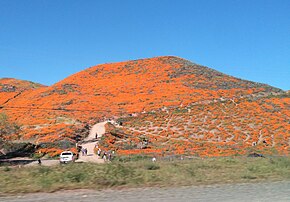Super bloom

A Super bloom is a rare botanical desert phenomenon in which an unusually high proportion of wild flowers whose seeds in the desert soil resting area have approximately germinate at the same time and blooms. The seeds are surrounded by a thick shell or layer of wax that allows them to survive in the desert soil for decades. The phenomenon is associated with an unusually humid rainy season. The term super bloom may have developed in the 1990s.
Necessary conditions and procedure
A super bloom can only occur under exceptional conditions. Because some invasive grasses, such as bristles, compete with native flowers for moisture, the desert must remain dry enough before flowering so that they do not establish themselves. The desert must receive rainfall in the fall, and that rain must penetrate deeply into the soil matrix to reach much of the dormant seeds of flowering plants. If the subsequent rainfall is too heavy, the young plants can be carried away in flash floods . If it doesn't rain enough, the seeds dry up.
Next, the soil on which the seeds lie must slowly warm up in the months following the first drenching rain, and the desert must have sufficient cloud cover to protect the soil from intense desert heat during the day and from frost overnight to protect. Once the newly sprouted plants reach the surface of the soil, the desert must remain undisturbed by strong winds that would uproot the plants or damage the young shoots. The rare concatenation of these events makes a super bloom such an extraordinary event.
In California, the most common super bloom plants are Encelia farinosa (yellow flowers), California poppies (bright orange), bluebells (deep purple), lupins (purple), sand verbenas (yellow), desert sunflowers (bright yellow) and evening primrose (mostly white, occasionally yellow), popcorn flowers (white or yellow), and desert lilies (white). Some of these plants are also invasive, such as field mustard .
In California, super blooms usually appear about every ten years. The ongoing drought in the state has made that less likely, although the 2019 super bloom came just two years after that of 2017.
Problematic effects from tourists
Due to the massive influx of tourists, flowers have been trampled, plucked and uprooted. In addition, massive traffic jams in the cars the tourists were using caused Lake Elsinore , California authorities to block access to Walker Canyon .
See also
Web links
swell
- ↑ Ecology: The desert is blooming again. Retrieved April 23, 2020 .
- ↑ a b c Holly Ober: Superbloom? If you say so . In: UC Riverside News . 15th March 2019.
- ↑ Eleanor Imster: Rare super bloom in California's Death Valley . In: EarthSky . February 26, 2016.
- ^ A b Roger W. Thompson: We Stood Upon Stars. Finding God in Lost Places. 1st edition. Colorado Springs, ISBN 978-1-60142-959-9 , pp. 160 .
- ^ Sara Combs, Rich Combs: At Home in Joshua Tree. A Field Guide to Desert Living. 1st edition. New York, ISBN 0-7624-9167-1 , pp. 181 .
- ^ Superbloom of California poppies put the gold in Golden State . In: The Mercury News . March 6, 2019. Retrieved March 25, 2019.
- ^ Sarah Trott: What to know before heading out to see the Superbloom . In: KESQ . February 26, 2019. Archived from the original on March 27, 2019. Retrieved on March 25, 2019.
- ↑ Erika Martin: Here's How to Take in the Impressive Wildflower Blooms Popping up Across Southern California . In: KTLA . 5th March 2019.
- ↑ Where to See a 'Super Bloom' in the Bay Area . In: KQED . March 19, 2019. Retrieved March 25, 2019.
- ↑ Daniel Lingenhöhl: Ecology: Valley of Death expects super bloom. In: Spektrum.de. February 19, 2016, accessed April 24, 2020 .
- ↑ Alice Bryant: Rain Brings Second California Super Bloom in Two Years . In: VOANews . March 11, 2019.
- ↑ Gabrielle Canon: The vigilante shaming influencers for bad behavior in national parks . In: The Guardian . April 9, 2019, ISSN 0261-3077 ( theguardian.com [accessed April 23, 2020]).
- ↑ Instagram-hungry crowds are destroying the super bloom. March 14, 2019, accessed April 23, 2020 (American English).
